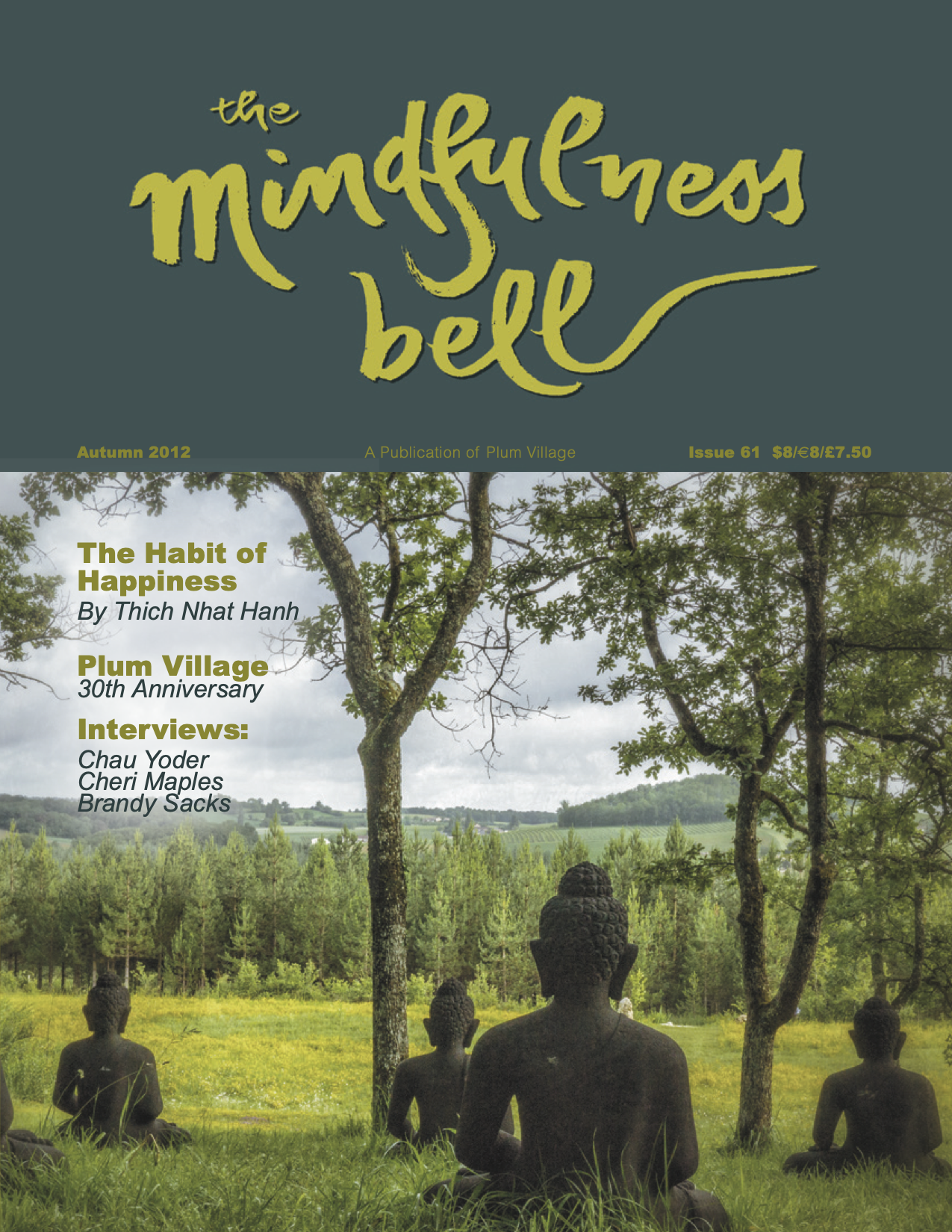Living in Sangha Paradise
By Brother Chan Phap Nguyen
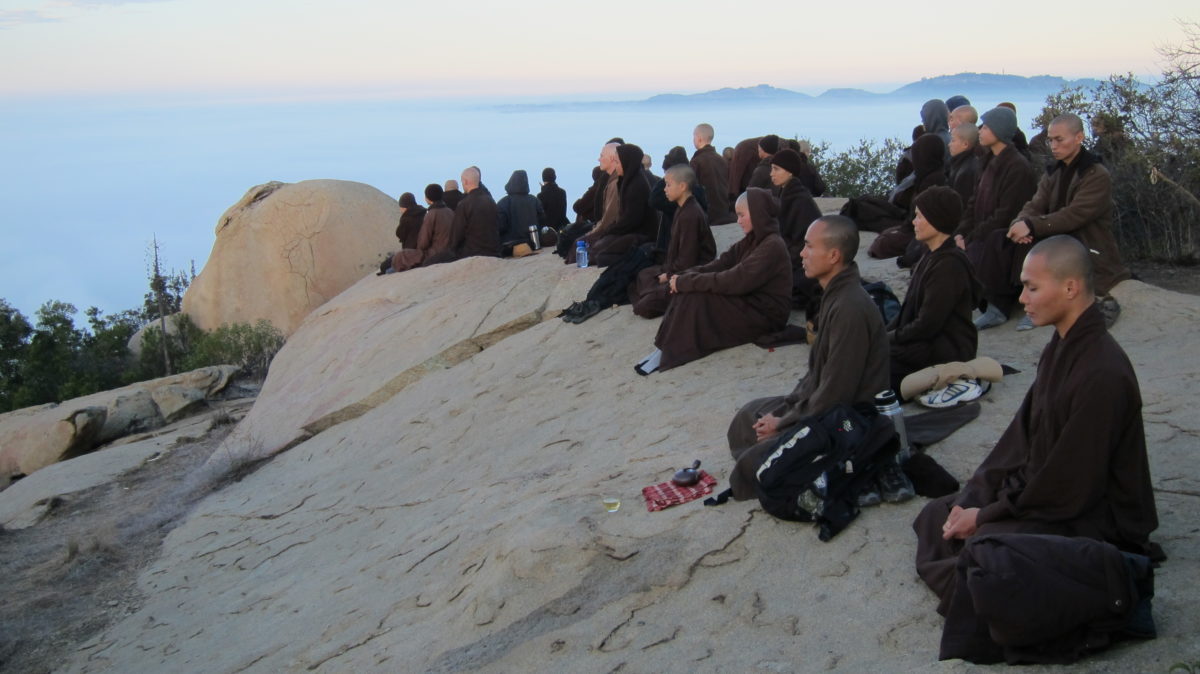
A mist thickly covers the forests and mountains of Deer Park Monastery. The entire practice center is embraced by an atmosphere of stillness. The activity bell wakes all from slumber at exactly 5:00 a.m., followed by reverberating sounds of the Great Temple Bell in front of the Ocean of Peace Meditation Hall.
Living in Sangha Paradise
By Brother Chan Phap Nguyen

A mist thickly covers the forests and mountains of Deer Park Monastery. The entire practice center is embraced by an atmosphere of stillness. The activity bell wakes all from slumber at exactly 5:00 a.m., followed by reverberating sounds of the Great Temple Bell in front of the Ocean of Peace Meditation Hall. The powerful sounds of the bell, harmonizing with the light and flowing voice of a sister chanting, enhance the peacefulness of a new day.
Today is the fourth day of a five-day retreat, “Opening the Door of Your Heart,” for people who speak Vietnamese. In the tranquil atmosphere of the morning, the Sangha queues up to get a packed breakfast in preparation for hiking up the misty mountain and enjoying their first meal of the day. About 500 monastic and lay friends practice walking meditation along the winding path. When the Sangha reaches Elephant Peak, some people are, perhaps, surprised to see Thay already seated in meditation with his attendants. Standing here, one faces an ocean of clouds that covers an area of the city of Escondido. It feels as if one is hovering among the clouds of a faraway land of enchantment. It is truly a Zen experience to be in the spaciousness of earth and grand open sky. Everyone finds a comfortable place to sit among the huge flat rock formations that have been here for hundreds of years.
After practicing sitting meditation for half an hour, I slowly open my eyes to see that the sun has risen and made the sea of clouds appear even clearer. The Sangha begins eating breakfast in silence. After some time, Thay shows me a cluster of tiny ants carrying crumbs dropped from our rice cakes. They carry their food in just one direction. Some ants move rice cake crumbs or potato skins many times larger than themselves. Sometimes two or three ants clutch one piece together. Thay compassionately gives them some more food that they can bring back to their nest for the colony to enjoy.
Thay tells me to take a photo of these ants. I do so and feel curious about where they are taking these provisions and how big their colony is. I follow their trail and feel pity to see how small they are, because they have to carry food so much larger than their bodies. Their paths wind up and down the rock surface. Some lose their balance and topple over due to their heavy load. I just let them be and don’t interfere, as if I were not there. My observation takes me to the entrance of their nest, a crack in the rock with a lot of sand surrounding it. I feel despondent that I can’t continue farther while they unaffectedly carry on their task. A sense of curiosity continues in my store consciousness for the next few days.
Like A Colony of Ants
Recently, I saw a short documentary film called “Animal Planet,” which examined the life and activities of a colony of ants. Thousands of them followed each other in a meadow of tall green grass that resembled the young plants in a rice paddy. Many climbed grass stems and bit off young shoots, while those on the ground carried the shoots back to the nest. Each had its own particular task to do, be it to bite off the shoots, transport provisions, or remain inside to build the underground nest from the grass that had been carried back. They seemed to work like an ensemble without a leader or discrimination. None of them seemed to complain about each other. The way they lived reminded me of our Sangha.
As brothers and sisters in the Dharma, we work together like ants in a colony, or like cells in a body. In a body, there is no single cell that is considered the leader of all other cells. A retreatant once asked one of our sisters who plays the violin, “Why does Thay travel with so many monastics when he goes on a teaching tour?” She replied, “It doesn’t make sense for a conductor to go on a concert tour without his orchestra.” The conductor would not attract an audience by himself; yet if there were no conductor, the quality of music produced by the orchestra would not be very high. Thay has never wanted to control us. He only seeks to open doors and clear obstacles for us. Thay just allows things to unfold naturally and tries to find the best way to help all of us develop our various talents. We inter-depend on one another; we inter-are with each other. When our individual skills are combined, they no longer belong to any particular person, but become the effectiveness of the whole Sangha.
Whether we are at our monastery or on the road, and especially during the recent retreats in North America, our brothers and sisters live and work together like a colony of ants; we flow as a river. Our 2011 U.S. Tour, which spanned three months, included five public talks, eight Days of Mindfulness (DOM), an exhibition of Thay’s calligraphy, seven retreats in as many states, a half DOM with the Google staff at their headquarters in California, and a talk for congressmen and women in Washington, D.C. Each retreat had from eight hundred to one thousand participants, the DOMs had from one thousand to sixteen hundred people, and the public talks attracted approximately twenty five hundred attendees. The majority of activities were organized by monastic brothers and sisters. The tour took the organizing team two years to plan.
We work together as an ensemble, and each person is allocated a task: some oversee logistics, others take care of registration, and others welcome and orient retreatants. Some brothers and sisters do the grocery shopping while others cook. Some manage the accommodations and others are in charge of hygiene. We have a transportation coordinator and children’s program supervisors. A team films the Dharma talks, a team produces the DVDs, and a team sells Thay’s calligraphies and books. All these tasks are tightly coordinated, and they all relate to each other.
When we’re on big teaching tours and retreats, the brothers and sisters do much work, but there are rarely complaints or criticism. Glitches are opportunities for us to learn new things and better understand each other. One brother is the treasurer, and he is on a cooking team, the CD producing team, and the organizing team. He has such a lot of work to do, but he is always fresh, smiling, and full of energy! One time when I saw that he had a great deal of bookkeeping work to do, I said to him, “Dear brother, you have so much work to do. May I give you a hand?” He looked at me kindly and replied, “The paperwork is a bit complicated. It’s okay, I’ll do it.” I continued, “But please take care of your health.” He smiled and said in his humorous way, “There’s no need to live a long life. Forty years is enough!” Matching his wit, I replied, “Thay has said that whoever goes before he does is not showing enough filial piety! The Buddha and Thay have entrusted their mission to us, so we can’t go so early!” We both laughed.
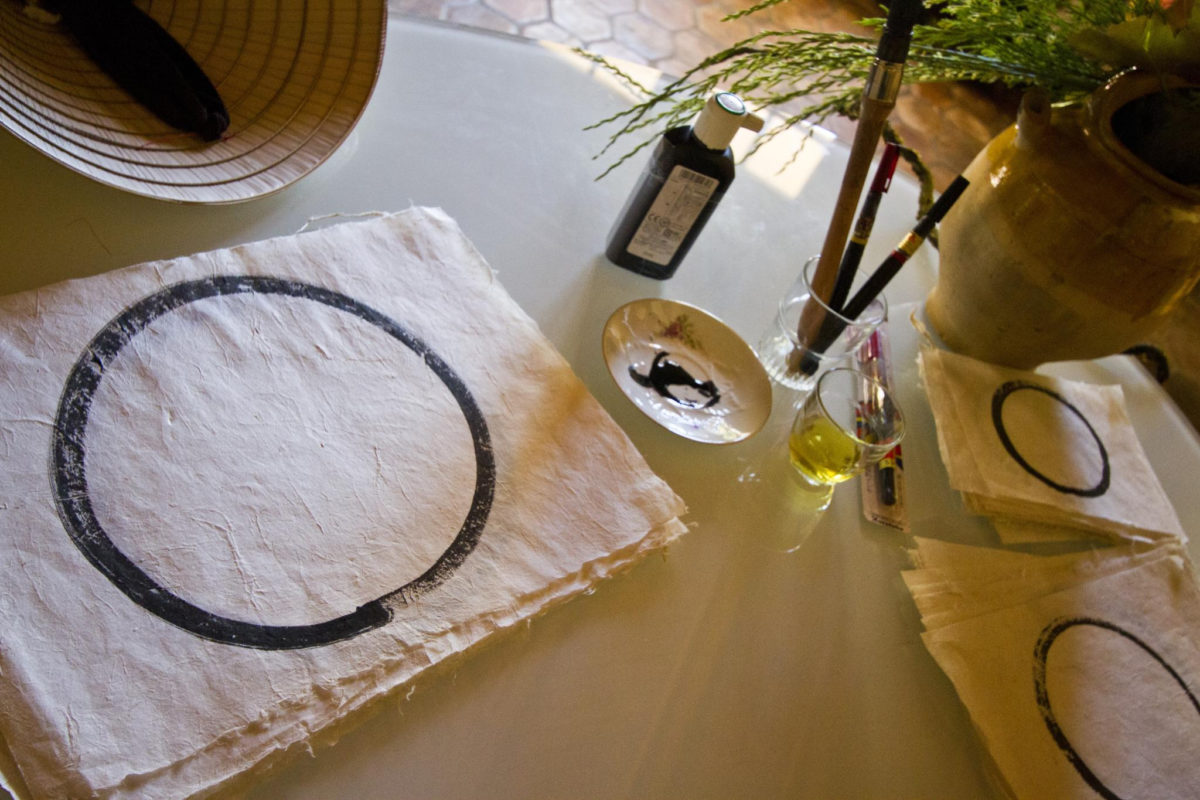
Recognizing Paradise
During our retreats there is much joy, and peals of laughter can be heard everywhere, especially in the kitchen. Each kitchen team has only five or six people, but they cook for over a thousand retreatants. They do so with happiness cultivated from the love of brotherhood and sisterhood. One day I went into the kitchen and saw a sister at the stove frying tofu. I was surprised at how tall she was that day, and then I realized that she was standing on a step in order to comfortably reach the stove top. I saw the large tray of delicious fried tofu pieces, and thought it must have taken her quite some time to fry all of that tofu in the midday heat, yet her face was still fresh. I said to her, “Sister, you are so good!”
An elder brother had been assigned to that same cooking team. He was cooking a huge pot of curry and using a large wooden ladle to stir. The curry was appealing, but the most amusing sight was that the pot was as tall as his ribs! This pot surely would need to be carried by three or four people. I had a funny thought: Cooking like this, one does not need to go to the gym and lift weights! I felt very happy because I knew for sure that the food cooked by the brothers and sisters had a lot of love in it, and that the retreatants would be able to taste and enjoy it.
When I have a bit of spare time during a tour, I like to watch children play together; I think they look like innocent angels. I particularly relish hearing their spontaneous laughter echoing in the summer air. At least a few dozen children come with their parents to each retreat. Brothers and sisters take care of the children’s program very skillfully; they are mostly “baby monks” or “baby nuns” who have grown up in the monastery. They wholeheartedly guide, play with, and offer their presence to the children. That’s why the children who attend Plum Village retreats are so happy. When I look into the bright eyes of these children, I know that we are sowing good seeds in them—seeds of peace, happiness, and liberation.
I also like to drop by the bookshop to see Thay’s new calligraphy, which helps remind people to practice mindfulness at home. The calligraphies may say, for example, “Breathe, my dear,” or “Peace is every step,” or “Happiness begins with your lovely smile.” The calligraphy stand is always full of people. An elder sister is happily helping her younger sisters distribute the calligraphies, even though she has many other things to do. Promoting calligraphy involves more than just selling individual sheets; there are also elements of practice and play. People often have many questions about the meaning of Thay’s calligraphies; therefore the stand is like a Dharma hall. This is an opportunity for elder sisters to pass on their experience to younger ones, while also working to serve and liberate all beings. The elder sisters explain the calligraphies in a dynamic way, while the younger sisters’ fresh faces and witty comments attract visitors, as well.
Despite the crowds, the atmosphere at retreats is serene and peaceful. One practitioner commented, “Even though there are about a thousand retreatants here, it doesn’t feel like it. The atmosphere here is totally different from outside.” There are not only those who are experienced in the practices of Plum Village, but also many newcomers. The long-time practitioners are a much-needed foundation and source of support for newer practitioners. During one walking meditation session full of people, one retreatant exclaimed, “This is a miracle! We are walking in paradise!” Thanks to the mindful presence and collective energy of the Sangha, we can recognize this paradise.
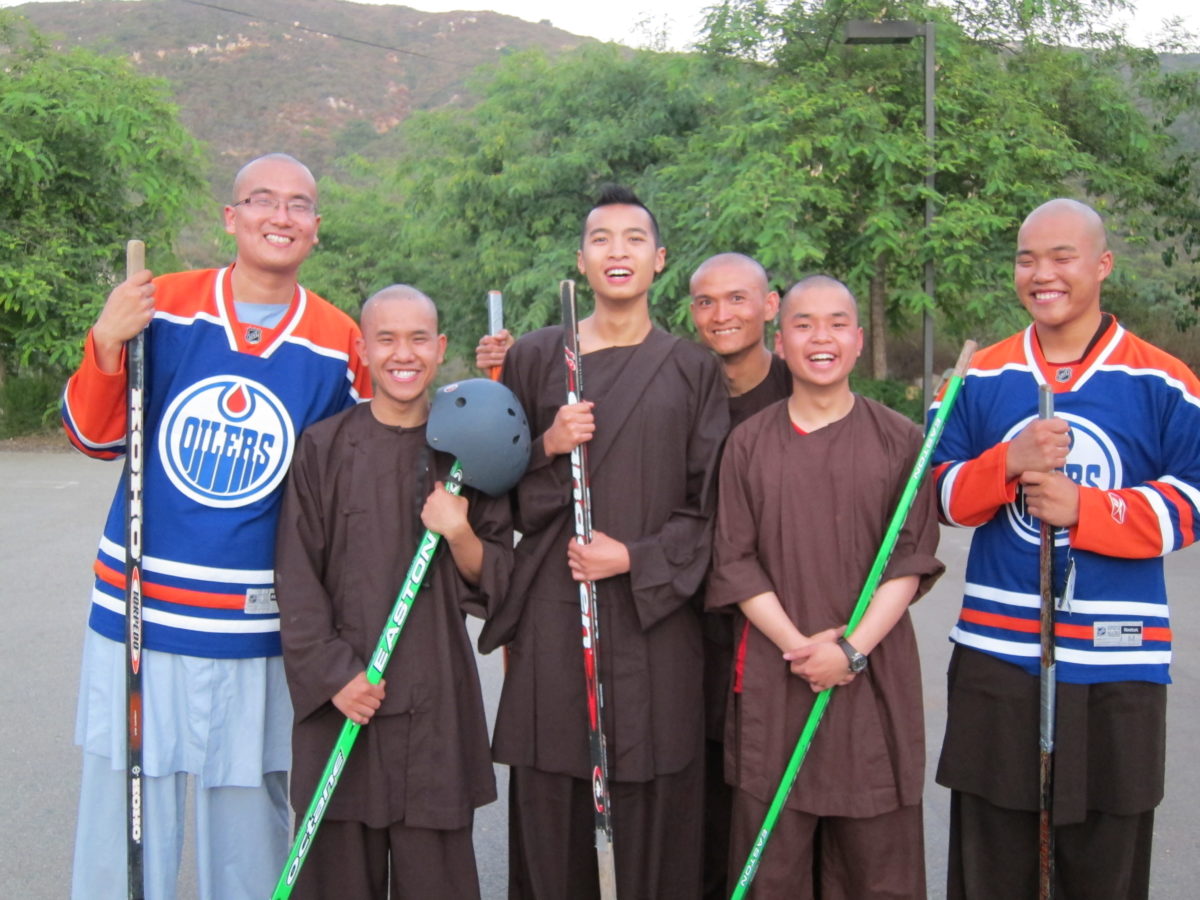
Our Source of Energy
During a Dharma sharing session at Estes Park, Colorado, one retreatant commented, “In this retreat there are up to eight hundred people and everything is done by the brothers and sisters. I’m truly surprised to see that you do all of these things so wholeheartedly. I’m curious to know how you all have so much energy.” I looked at her and simply replied, “Your tears and smiles are our source of energy.” It is true that there are tears from pain and suffering, but there are also tears born of happiness. And smiles are signs of joy, peace, happiness, and transformation. Both tears and smiles are a source of inspiration that nourishes our mind of love. That is why we have so much energy to continue what we are doing. I feel so nourished and happy as a monastic because my brothers and sisters and I have come across a way of practice that is relevant to us. We are able to continue the Buddha’s task of liberating beings in the way that Thay has transmitted to us.
Personally, I think we monastics benefit the most from these retreats. When we conduct such retreats, we have the opportunity to come in contact with the suffering of people from many sectors of society. As monastics, there are places that we cannot go; there are things that only laypeople can do. However, through our interactions with lay friends, and listening to their life experiences and suffering, we are able to see different aspects of life more clearly. Sometimes, just by listening, we alleviate much of their pain and suffering. When I’m able to sit and listen to people’s deepest pain and hidden difficulties, then naturally the energy of compassion arises within me. This kind of energy makes me so happy whenever I’m able to generate it.
I think it’s truly wonderful to be a monastic, especially when I have the chance to help others. In my opinion, “miraculous” things don’t need to be lofty; it is what I can do every day that counts. To be able to help others benefit from their practice, to bring about healing, transformation, happiness, peace, and joy in others is already a miracle. My life is so fulfilling and happy. What else is there to search for?
The Spirit of Sangha
We monastics spend much time learning, practicing, and conducting retreats. Another art needs to be nourished every day, as well: the art of developing brotherhood and sisterhood. This is the foundation of happiness in our daily practice. Everything we do holds the purpose of building brotherhood and sisterhood, and drinking tea together is one of our favourite methods for doing so. Drinking tea is a meditation practice. Each pot of tea contains so many joyful stories that we share with each other, especially after a session of sitting meditation and chanting. And nothing beats hiking up a mountain and drinking tea together there. Our daily activities have all the elements of mindfulness practice, play, work, and learning. It is only when we live and work in this spirit of inclusiveness and inter-relatedness that large-scale teaching tours can be successful and beneficial for practitioners.
Living and practicing in the Sangha, as well as going on teaching tours with Thay, have given me a precious lesson—anything can be accomplished when we have ideals, aspirations, brotherhood, and sisterhood. Further, when we are able to let go of our individualism, then we can easily flow with togetherness. That is the spirit of living in the Sangha, the spirit of non-self. That is the love of brotherhood and sisterhood.
There is a popular proverb in Vietnamese: “One stick cannot make a mountain, but three sticks together create a solid peak.” It is a sensible proverb that everyone likes and appreciates. Before I was ordained, it did not hold much meaning for me. It was merely a nice idea. But after becoming a monk, having lived and practiced with the Sangha, I realize its depth and truth. I appreciate this proverb, thanks to the miraculous power of the Sangha and the wonders of a lifestyle of non-self. This lifestyle is truly a Sangha paradise.
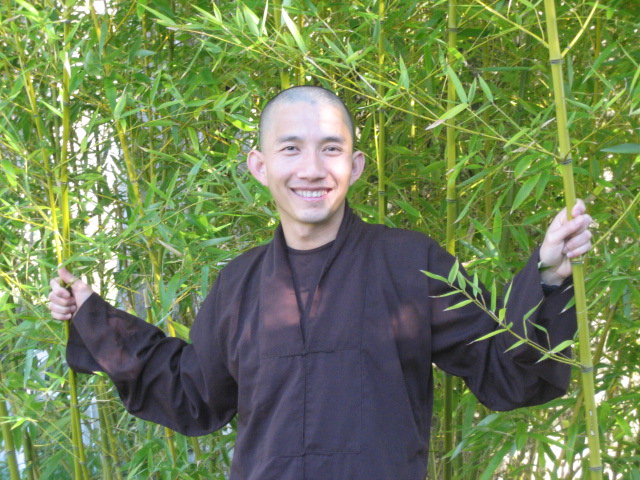
Brother Chan Phap Nguyen, born and raised in Vietnam, immigrated to the U.S. with his family at age thirteen. He became a monk in February 2008 and has lived in Plum Village ever since. He enjoys drinking tea and lying on a hammock.

